Analyzing Marketing Principles, Decisions, and STP at J Sainsbury Plc
VerifiedAdded on 2023/06/18
|12
|3847
|259
Report
AI Summary
This report provides a comprehensive analysis of the sales and marketing strategies employed by J Sainsbury Plc, a leading UK supermarket chain. It begins by evaluating key marketing principles, including the 7 Ps (Product, Price, Place, Promotion, Physical Evidence, People, and Process), and their implementation within the organization. The report then appraises the rationale behind Sainsbury's marketing decisions, emphasizing the importance of marketing in strategic planning and its interconnectedness with other organizational functions such as research, supply chain management, and finance. Finally, it assesses the concepts of segmentation, targeting, and positioning (STP) specific to Sainsbury's, illustrating how the company tailors its marketing efforts to effectively reach different customer groups based on age, gender, income, lifestyle, and values, ultimately aiming to enhance customer experience and maintain a competitive edge in the market.

SALES AND
MARKETING
MARKETING
Paraphrase This Document
Need a fresh take? Get an instant paraphrase of this document with our AI Paraphraser
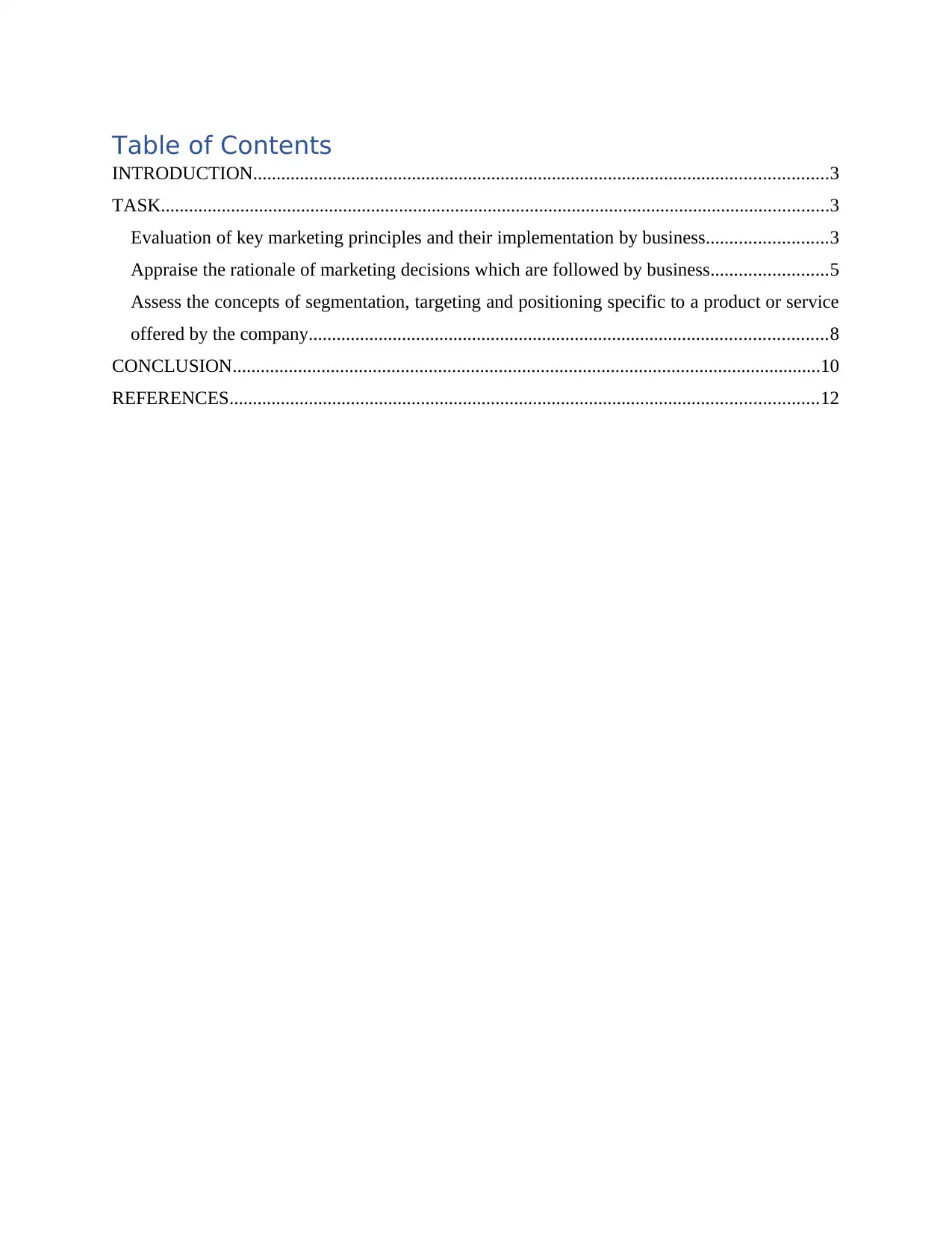
Table of Contents
INTRODUCTION...........................................................................................................................3
TASK...............................................................................................................................................3
Evaluation of key marketing principles and their implementation by business..........................3
Appraise the rationale of marketing decisions which are followed by business.........................5
Assess the concepts of segmentation, targeting and positioning specific to a product or service
offered by the company...............................................................................................................8
CONCLUSION..............................................................................................................................10
REFERENCES..............................................................................................................................12
INTRODUCTION...........................................................................................................................3
TASK...............................................................................................................................................3
Evaluation of key marketing principles and their implementation by business..........................3
Appraise the rationale of marketing decisions which are followed by business.........................5
Assess the concepts of segmentation, targeting and positioning specific to a product or service
offered by the company...............................................................................................................8
CONCLUSION..............................................................................................................................10
REFERENCES..............................................................................................................................12
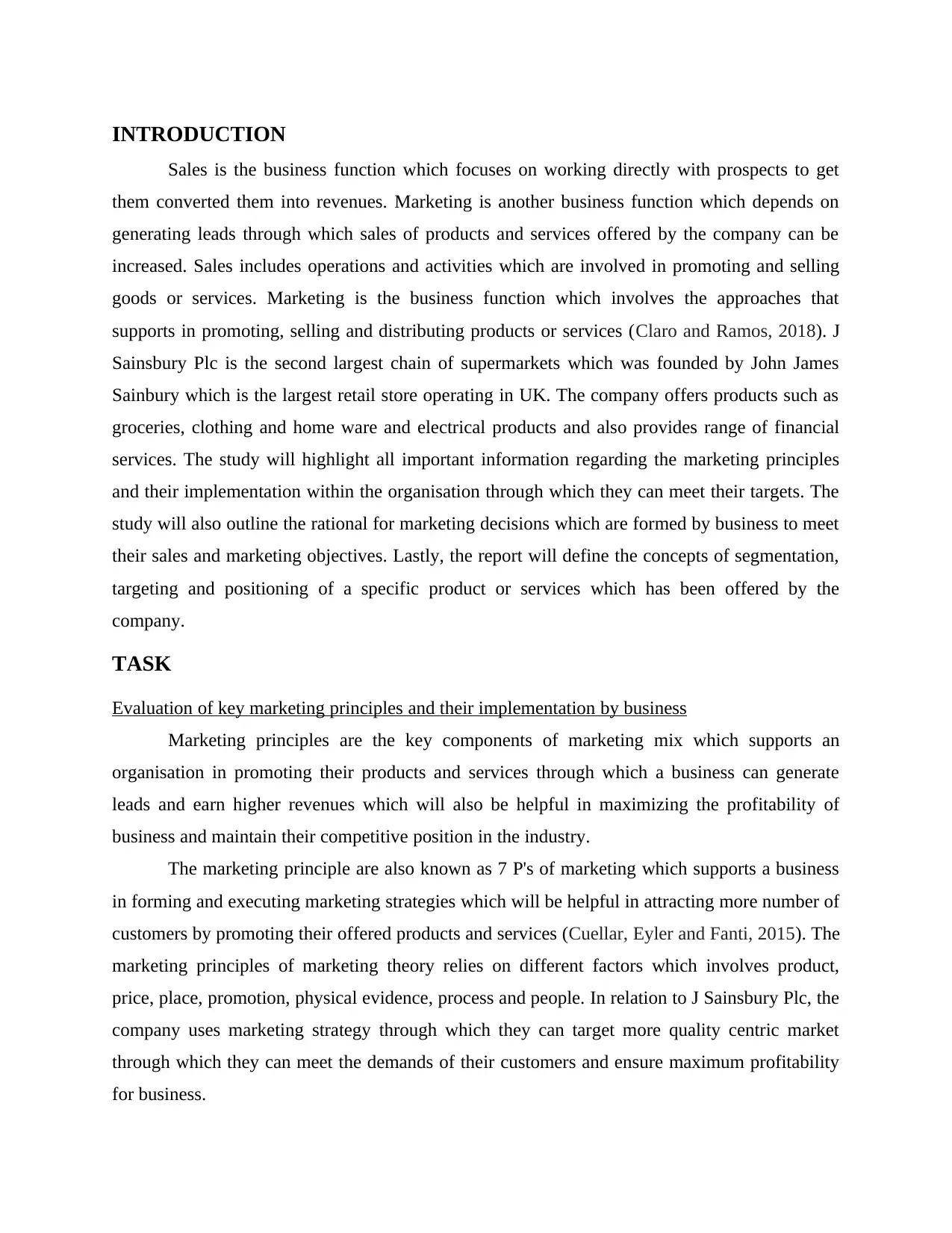
INTRODUCTION
Sales is the business function which focuses on working directly with prospects to get
them converted them into revenues. Marketing is another business function which depends on
generating leads through which sales of products and services offered by the company can be
increased. Sales includes operations and activities which are involved in promoting and selling
goods or services. Marketing is the business function which involves the approaches that
supports in promoting, selling and distributing products or services (Claro and Ramos, 2018). J
Sainsbury Plc is the second largest chain of supermarkets which was founded by John James
Sainbury which is the largest retail store operating in UK. The company offers products such as
groceries, clothing and home ware and electrical products and also provides range of financial
services. The study will highlight all important information regarding the marketing principles
and their implementation within the organisation through which they can meet their targets. The
study will also outline the rational for marketing decisions which are formed by business to meet
their sales and marketing objectives. Lastly, the report will define the concepts of segmentation,
targeting and positioning of a specific product or services which has been offered by the
company.
TASK
Evaluation of key marketing principles and their implementation by business
Marketing principles are the key components of marketing mix which supports an
organisation in promoting their products and services through which a business can generate
leads and earn higher revenues which will also be helpful in maximizing the profitability of
business and maintain their competitive position in the industry.
The marketing principle are also known as 7 P's of marketing which supports a business
in forming and executing marketing strategies which will be helpful in attracting more number of
customers by promoting their offered products and services (Cuellar, Eyler and Fanti, 2015). The
marketing principles of marketing theory relies on different factors which involves product,
price, place, promotion, physical evidence, process and people. In relation to J Sainsbury Plc, the
company uses marketing strategy through which they can target more quality centric market
through which they can meet the demands of their customers and ensure maximum profitability
for business.
Sales is the business function which focuses on working directly with prospects to get
them converted them into revenues. Marketing is another business function which depends on
generating leads through which sales of products and services offered by the company can be
increased. Sales includes operations and activities which are involved in promoting and selling
goods or services. Marketing is the business function which involves the approaches that
supports in promoting, selling and distributing products or services (Claro and Ramos, 2018). J
Sainsbury Plc is the second largest chain of supermarkets which was founded by John James
Sainbury which is the largest retail store operating in UK. The company offers products such as
groceries, clothing and home ware and electrical products and also provides range of financial
services. The study will highlight all important information regarding the marketing principles
and their implementation within the organisation through which they can meet their targets. The
study will also outline the rational for marketing decisions which are formed by business to meet
their sales and marketing objectives. Lastly, the report will define the concepts of segmentation,
targeting and positioning of a specific product or services which has been offered by the
company.
TASK
Evaluation of key marketing principles and their implementation by business
Marketing principles are the key components of marketing mix which supports an
organisation in promoting their products and services through which a business can generate
leads and earn higher revenues which will also be helpful in maximizing the profitability of
business and maintain their competitive position in the industry.
The marketing principle are also known as 7 P's of marketing which supports a business
in forming and executing marketing strategies which will be helpful in attracting more number of
customers by promoting their offered products and services (Cuellar, Eyler and Fanti, 2015). The
marketing principles of marketing theory relies on different factors which involves product,
price, place, promotion, physical evidence, process and people. In relation to J Sainsbury Plc, the
company uses marketing strategy through which they can target more quality centric market
through which they can meet the demands of their customers and ensure maximum profitability
for business.
⊘ This is a preview!⊘
Do you want full access?
Subscribe today to unlock all pages.

Trusted by 1+ million students worldwide
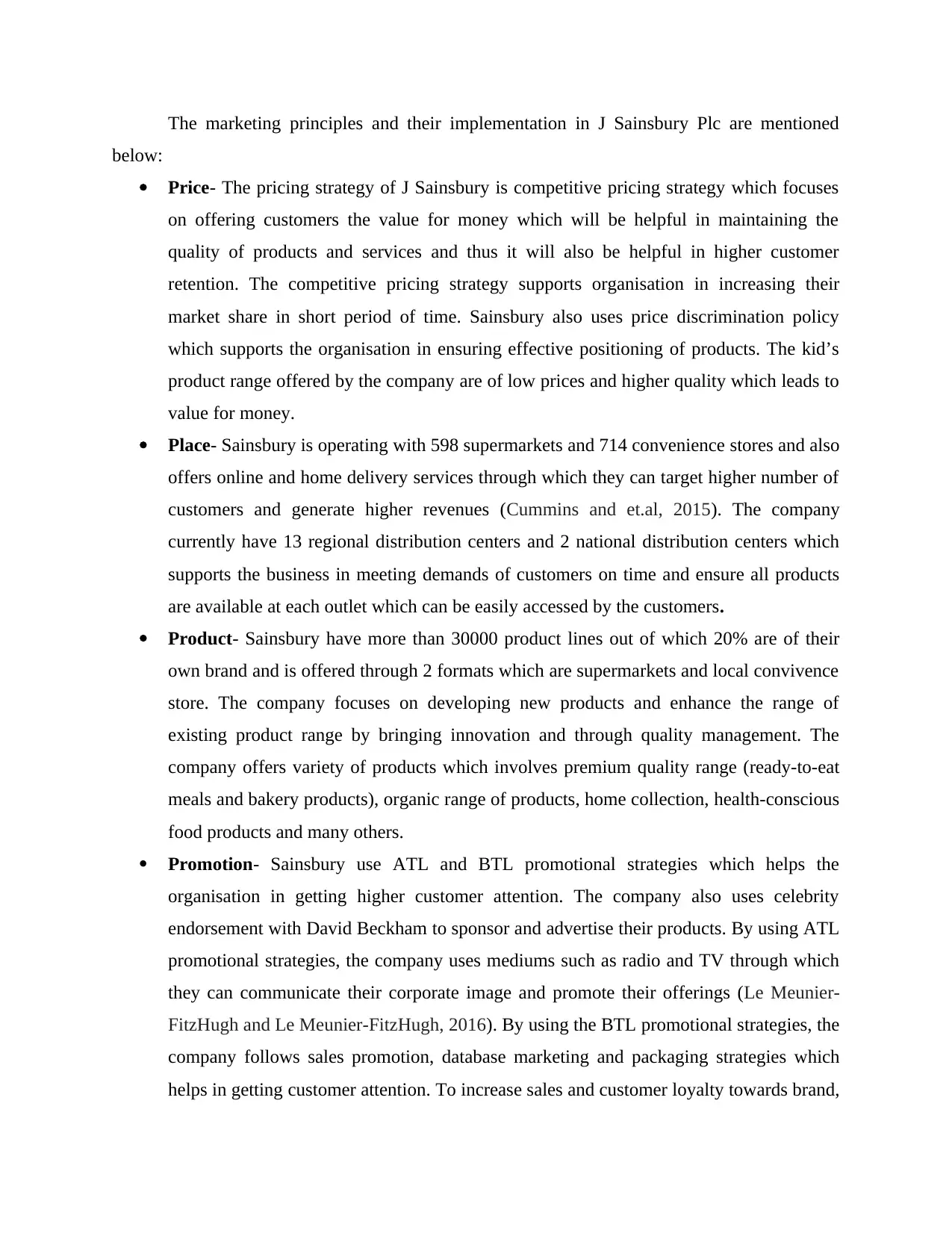
The marketing principles and their implementation in J Sainsbury Plc are mentioned
below:
Price- The pricing strategy of J Sainsbury is competitive pricing strategy which focuses
on offering customers the value for money which will be helpful in maintaining the
quality of products and services and thus it will also be helpful in higher customer
retention. The competitive pricing strategy supports organisation in increasing their
market share in short period of time. Sainsbury also uses price discrimination policy
which supports the organisation in ensuring effective positioning of products. The kid’s
product range offered by the company are of low prices and higher quality which leads to
value for money.
Place- Sainsbury is operating with 598 supermarkets and 714 convenience stores and also
offers online and home delivery services through which they can target higher number of
customers and generate higher revenues (Cummins and et.al, 2015). The company
currently have 13 regional distribution centers and 2 national distribution centers which
supports the business in meeting demands of customers on time and ensure all products
are available at each outlet which can be easily accessed by the customers.
Product- Sainsbury have more than 30000 product lines out of which 20% are of their
own brand and is offered through 2 formats which are supermarkets and local convivence
store. The company focuses on developing new products and enhance the range of
existing product range by bringing innovation and through quality management. The
company offers variety of products which involves premium quality range (ready-to-eat
meals and bakery products), organic range of products, home collection, health-conscious
food products and many others.
Promotion- Sainsbury use ATL and BTL promotional strategies which helps the
organisation in getting higher customer attention. The company also uses celebrity
endorsement with David Beckham to sponsor and advertise their products. By using ATL
promotional strategies, the company uses mediums such as radio and TV through which
they can communicate their corporate image and promote their offerings (Le Meunier-
FitzHugh and Le Meunier-FitzHugh, 2016). By using the BTL promotional strategies, the
company follows sales promotion, database marketing and packaging strategies which
helps in getting customer attention. To increase sales and customer loyalty towards brand,
below:
Price- The pricing strategy of J Sainsbury is competitive pricing strategy which focuses
on offering customers the value for money which will be helpful in maintaining the
quality of products and services and thus it will also be helpful in higher customer
retention. The competitive pricing strategy supports organisation in increasing their
market share in short period of time. Sainsbury also uses price discrimination policy
which supports the organisation in ensuring effective positioning of products. The kid’s
product range offered by the company are of low prices and higher quality which leads to
value for money.
Place- Sainsbury is operating with 598 supermarkets and 714 convenience stores and also
offers online and home delivery services through which they can target higher number of
customers and generate higher revenues (Cummins and et.al, 2015). The company
currently have 13 regional distribution centers and 2 national distribution centers which
supports the business in meeting demands of customers on time and ensure all products
are available at each outlet which can be easily accessed by the customers.
Product- Sainsbury have more than 30000 product lines out of which 20% are of their
own brand and is offered through 2 formats which are supermarkets and local convivence
store. The company focuses on developing new products and enhance the range of
existing product range by bringing innovation and through quality management. The
company offers variety of products which involves premium quality range (ready-to-eat
meals and bakery products), organic range of products, home collection, health-conscious
food products and many others.
Promotion- Sainsbury use ATL and BTL promotional strategies which helps the
organisation in getting higher customer attention. The company also uses celebrity
endorsement with David Beckham to sponsor and advertise their products. By using ATL
promotional strategies, the company uses mediums such as radio and TV through which
they can communicate their corporate image and promote their offerings (Le Meunier-
FitzHugh and Le Meunier-FitzHugh, 2016). By using the BTL promotional strategies, the
company follows sales promotion, database marketing and packaging strategies which
helps in getting customer attention. To increase sales and customer loyalty towards brand,
Paraphrase This Document
Need a fresh take? Get an instant paraphrase of this document with our AI Paraphraser
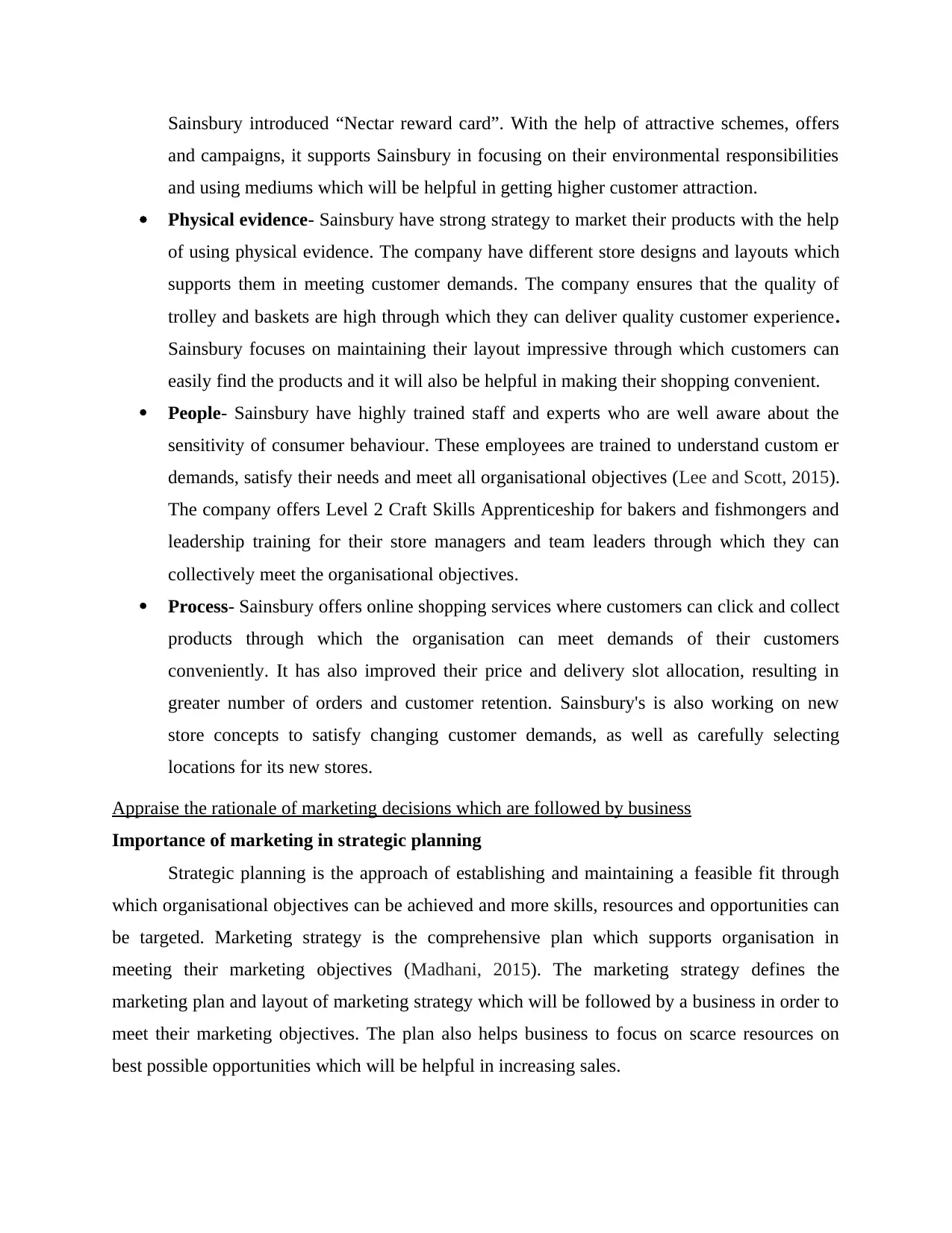
Sainsbury introduced “Nectar reward card”. With the help of attractive schemes, offers
and campaigns, it supports Sainsbury in focusing on their environmental responsibilities
and using mediums which will be helpful in getting higher customer attraction.
Physical evidence- Sainsbury have strong strategy to market their products with the help
of using physical evidence. The company have different store designs and layouts which
supports them in meeting customer demands. The company ensures that the quality of
trolley and baskets are high through which they can deliver quality customer experience.
Sainsbury focuses on maintaining their layout impressive through which customers can
easily find the products and it will also be helpful in making their shopping convenient.
People- Sainsbury have highly trained staff and experts who are well aware about the
sensitivity of consumer behaviour. These employees are trained to understand custom er
demands, satisfy their needs and meet all organisational objectives (Lee and Scott, 2015).
The company offers Level 2 Craft Skills Apprenticeship for bakers and fishmongers and
leadership training for their store managers and team leaders through which they can
collectively meet the organisational objectives.
Process- Sainsbury offers online shopping services where customers can click and collect
products through which the organisation can meet demands of their customers
conveniently. It has also improved their price and delivery slot allocation, resulting in
greater number of orders and customer retention. Sainsbury's is also working on new
store concepts to satisfy changing customer demands, as well as carefully selecting
locations for its new stores.
Appraise the rationale of marketing decisions which are followed by business
Importance of marketing in strategic planning
Strategic planning is the approach of establishing and maintaining a feasible fit through
which organisational objectives can be achieved and more skills, resources and opportunities can
be targeted. Marketing strategy is the comprehensive plan which supports organisation in
meeting their marketing objectives (Madhani, 2015). The marketing strategy defines the
marketing plan and layout of marketing strategy which will be followed by a business in order to
meet their marketing objectives. The plan also helps business to focus on scarce resources on
best possible opportunities which will be helpful in increasing sales.
and campaigns, it supports Sainsbury in focusing on their environmental responsibilities
and using mediums which will be helpful in getting higher customer attraction.
Physical evidence- Sainsbury have strong strategy to market their products with the help
of using physical evidence. The company have different store designs and layouts which
supports them in meeting customer demands. The company ensures that the quality of
trolley and baskets are high through which they can deliver quality customer experience.
Sainsbury focuses on maintaining their layout impressive through which customers can
easily find the products and it will also be helpful in making their shopping convenient.
People- Sainsbury have highly trained staff and experts who are well aware about the
sensitivity of consumer behaviour. These employees are trained to understand custom er
demands, satisfy their needs and meet all organisational objectives (Lee and Scott, 2015).
The company offers Level 2 Craft Skills Apprenticeship for bakers and fishmongers and
leadership training for their store managers and team leaders through which they can
collectively meet the organisational objectives.
Process- Sainsbury offers online shopping services where customers can click and collect
products through which the organisation can meet demands of their customers
conveniently. It has also improved their price and delivery slot allocation, resulting in
greater number of orders and customer retention. Sainsbury's is also working on new
store concepts to satisfy changing customer demands, as well as carefully selecting
locations for its new stores.
Appraise the rationale of marketing decisions which are followed by business
Importance of marketing in strategic planning
Strategic planning is the approach of establishing and maintaining a feasible fit through
which organisational objectives can be achieved and more skills, resources and opportunities can
be targeted. Marketing strategy is the comprehensive plan which supports organisation in
meeting their marketing objectives (Madhani, 2015). The marketing strategy defines the
marketing plan and layout of marketing strategy which will be followed by a business in order to
meet their marketing objectives. The plan also helps business to focus on scarce resources on
best possible opportunities which will be helpful in increasing sales.
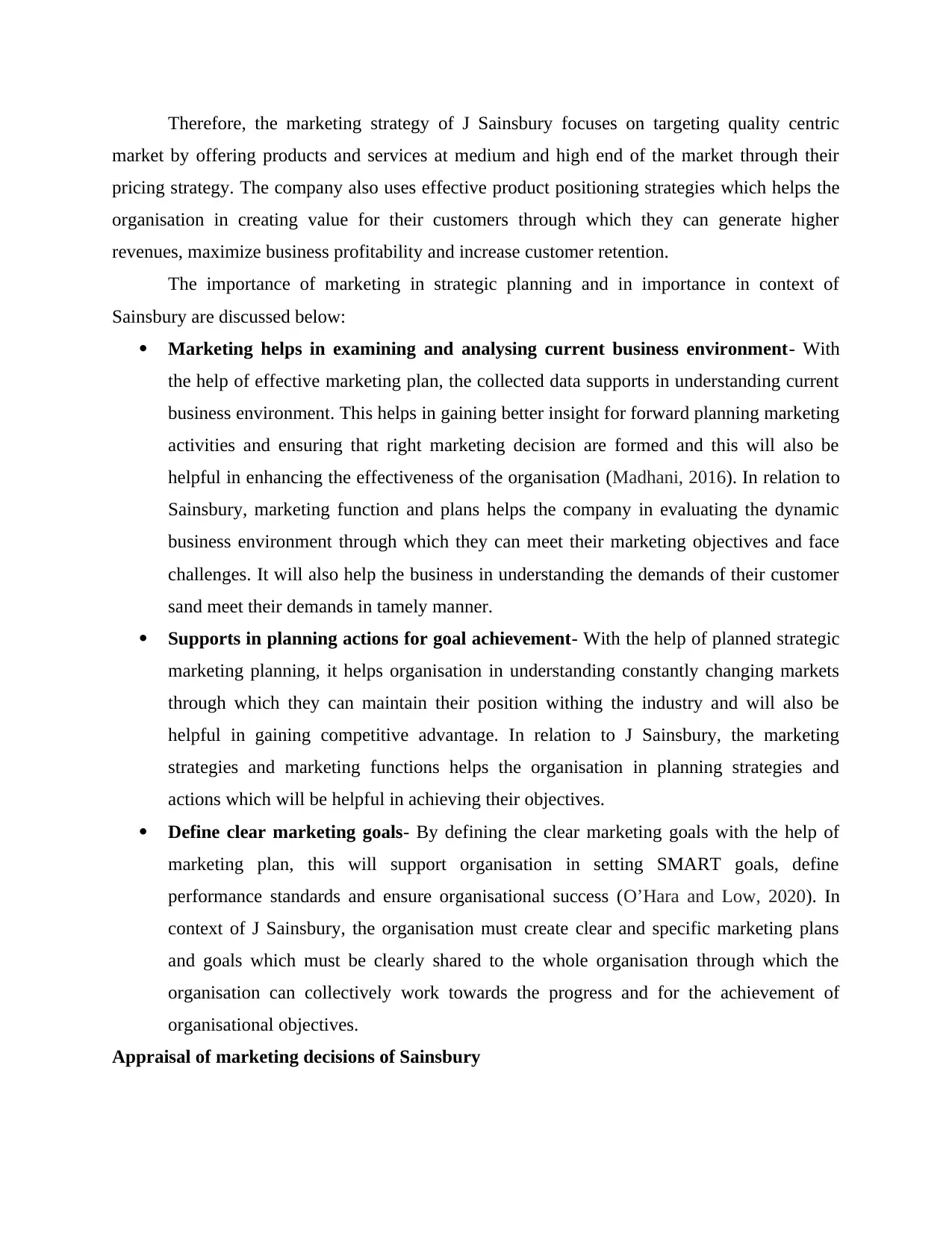
Therefore, the marketing strategy of J Sainsbury focuses on targeting quality centric
market by offering products and services at medium and high end of the market through their
pricing strategy. The company also uses effective product positioning strategies which helps the
organisation in creating value for their customers through which they can generate higher
revenues, maximize business profitability and increase customer retention.
The importance of marketing in strategic planning and in importance in context of
Sainsbury are discussed below:
Marketing helps in examining and analysing current business environment- With
the help of effective marketing plan, the collected data supports in understanding current
business environment. This helps in gaining better insight for forward planning marketing
activities and ensuring that right marketing decision are formed and this will also be
helpful in enhancing the effectiveness of the organisation (Madhani, 2016). In relation to
Sainsbury, marketing function and plans helps the company in evaluating the dynamic
business environment through which they can meet their marketing objectives and face
challenges. It will also help the business in understanding the demands of their customer
sand meet their demands in tamely manner.
Supports in planning actions for goal achievement- With the help of planned strategic
marketing planning, it helps organisation in understanding constantly changing markets
through which they can maintain their position withing the industry and will also be
helpful in gaining competitive advantage. In relation to J Sainsbury, the marketing
strategies and marketing functions helps the organisation in planning strategies and
actions which will be helpful in achieving their objectives.
Define clear marketing goals- By defining the clear marketing goals with the help of
marketing plan, this will support organisation in setting SMART goals, define
performance standards and ensure organisational success (O’Hara and Low, 2020). In
context of J Sainsbury, the organisation must create clear and specific marketing plans
and goals which must be clearly shared to the whole organisation through which the
organisation can collectively work towards the progress and for the achievement of
organisational objectives.
Appraisal of marketing decisions of Sainsbury
market by offering products and services at medium and high end of the market through their
pricing strategy. The company also uses effective product positioning strategies which helps the
organisation in creating value for their customers through which they can generate higher
revenues, maximize business profitability and increase customer retention.
The importance of marketing in strategic planning and in importance in context of
Sainsbury are discussed below:
Marketing helps in examining and analysing current business environment- With
the help of effective marketing plan, the collected data supports in understanding current
business environment. This helps in gaining better insight for forward planning marketing
activities and ensuring that right marketing decision are formed and this will also be
helpful in enhancing the effectiveness of the organisation (Madhani, 2016). In relation to
Sainsbury, marketing function and plans helps the company in evaluating the dynamic
business environment through which they can meet their marketing objectives and face
challenges. It will also help the business in understanding the demands of their customer
sand meet their demands in tamely manner.
Supports in planning actions for goal achievement- With the help of planned strategic
marketing planning, it helps organisation in understanding constantly changing markets
through which they can maintain their position withing the industry and will also be
helpful in gaining competitive advantage. In relation to J Sainsbury, the marketing
strategies and marketing functions helps the organisation in planning strategies and
actions which will be helpful in achieving their objectives.
Define clear marketing goals- By defining the clear marketing goals with the help of
marketing plan, this will support organisation in setting SMART goals, define
performance standards and ensure organisational success (O’Hara and Low, 2020). In
context of J Sainsbury, the organisation must create clear and specific marketing plans
and goals which must be clearly shared to the whole organisation through which the
organisation can collectively work towards the progress and for the achievement of
organisational objectives.
Appraisal of marketing decisions of Sainsbury
⊘ This is a preview!⊘
Do you want full access?
Subscribe today to unlock all pages.

Trusted by 1+ million students worldwide
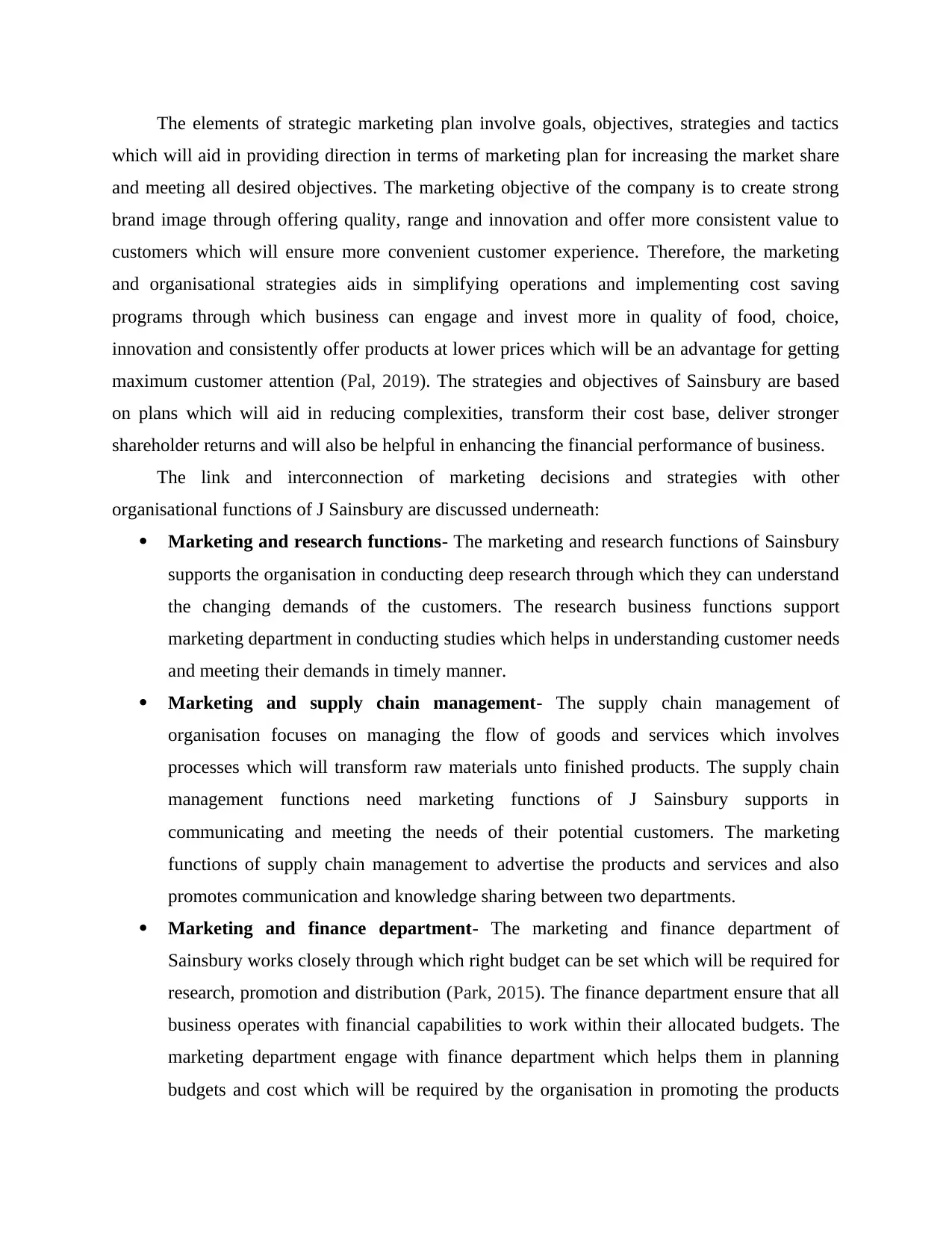
The elements of strategic marketing plan involve goals, objectives, strategies and tactics
which will aid in providing direction in terms of marketing plan for increasing the market share
and meeting all desired objectives. The marketing objective of the company is to create strong
brand image through offering quality, range and innovation and offer more consistent value to
customers which will ensure more convenient customer experience. Therefore, the marketing
and organisational strategies aids in simplifying operations and implementing cost saving
programs through which business can engage and invest more in quality of food, choice,
innovation and consistently offer products at lower prices which will be an advantage for getting
maximum customer attention (Pal, 2019). The strategies and objectives of Sainsbury are based
on plans which will aid in reducing complexities, transform their cost base, deliver stronger
shareholder returns and will also be helpful in enhancing the financial performance of business.
The link and interconnection of marketing decisions and strategies with other
organisational functions of J Sainsbury are discussed underneath:
Marketing and research functions- The marketing and research functions of Sainsbury
supports the organisation in conducting deep research through which they can understand
the changing demands of the customers. The research business functions support
marketing department in conducting studies which helps in understanding customer needs
and meeting their demands in timely manner.
Marketing and supply chain management- The supply chain management of
organisation focuses on managing the flow of goods and services which involves
processes which will transform raw materials unto finished products. The supply chain
management functions need marketing functions of J Sainsbury supports in
communicating and meeting the needs of their potential customers. The marketing
functions of supply chain management to advertise the products and services and also
promotes communication and knowledge sharing between two departments.
Marketing and finance department- The marketing and finance department of
Sainsbury works closely through which right budget can be set which will be required for
research, promotion and distribution (Park, 2015). The finance department ensure that all
business operates with financial capabilities to work within their allocated budgets. The
marketing department engage with finance department which helps them in planning
budgets and cost which will be required by the organisation in promoting the products
which will aid in providing direction in terms of marketing plan for increasing the market share
and meeting all desired objectives. The marketing objective of the company is to create strong
brand image through offering quality, range and innovation and offer more consistent value to
customers which will ensure more convenient customer experience. Therefore, the marketing
and organisational strategies aids in simplifying operations and implementing cost saving
programs through which business can engage and invest more in quality of food, choice,
innovation and consistently offer products at lower prices which will be an advantage for getting
maximum customer attention (Pal, 2019). The strategies and objectives of Sainsbury are based
on plans which will aid in reducing complexities, transform their cost base, deliver stronger
shareholder returns and will also be helpful in enhancing the financial performance of business.
The link and interconnection of marketing decisions and strategies with other
organisational functions of J Sainsbury are discussed underneath:
Marketing and research functions- The marketing and research functions of Sainsbury
supports the organisation in conducting deep research through which they can understand
the changing demands of the customers. The research business functions support
marketing department in conducting studies which helps in understanding customer needs
and meeting their demands in timely manner.
Marketing and supply chain management- The supply chain management of
organisation focuses on managing the flow of goods and services which involves
processes which will transform raw materials unto finished products. The supply chain
management functions need marketing functions of J Sainsbury supports in
communicating and meeting the needs of their potential customers. The marketing
functions of supply chain management to advertise the products and services and also
promotes communication and knowledge sharing between two departments.
Marketing and finance department- The marketing and finance department of
Sainsbury works closely through which right budget can be set which will be required for
research, promotion and distribution (Park, 2015). The finance department ensure that all
business operates with financial capabilities to work within their allocated budgets. The
marketing department engage with finance department which helps them in planning
budgets and cost which will be required by the organisation in promoting the products
Paraphrase This Document
Need a fresh take? Get an instant paraphrase of this document with our AI Paraphraser
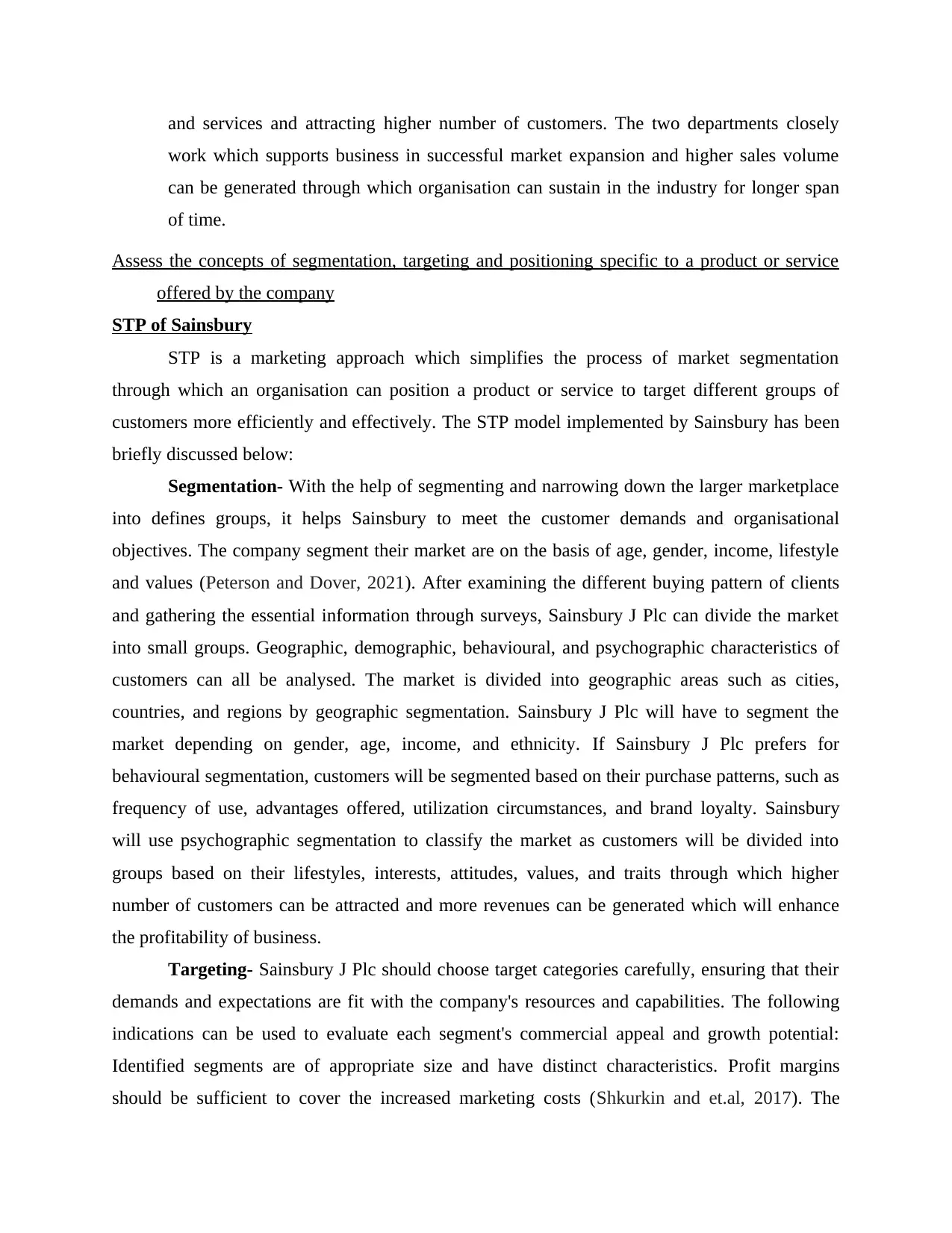
and services and attracting higher number of customers. The two departments closely
work which supports business in successful market expansion and higher sales volume
can be generated through which organisation can sustain in the industry for longer span
of time.
Assess the concepts of segmentation, targeting and positioning specific to a product or service
offered by the company
STP of Sainsbury
STP is a marketing approach which simplifies the process of market segmentation
through which an organisation can position a product or service to target different groups of
customers more efficiently and effectively. The STP model implemented by Sainsbury has been
briefly discussed below:
Segmentation- With the help of segmenting and narrowing down the larger marketplace
into defines groups, it helps Sainsbury to meet the customer demands and organisational
objectives. The company segment their market are on the basis of age, gender, income, lifestyle
and values (Peterson and Dover, 2021). After examining the different buying pattern of clients
and gathering the essential information through surveys, Sainsbury J Plc can divide the market
into small groups. Geographic, demographic, behavioural, and psychographic characteristics of
customers can all be analysed. The market is divided into geographic areas such as cities,
countries, and regions by geographic segmentation. Sainsbury J Plc will have to segment the
market depending on gender, age, income, and ethnicity. If Sainsbury J Plc prefers for
behavioural segmentation, customers will be segmented based on their purchase patterns, such as
frequency of use, advantages offered, utilization circumstances, and brand loyalty. Sainsbury
will use psychographic segmentation to classify the market as customers will be divided into
groups based on their lifestyles, interests, attitudes, values, and traits through which higher
number of customers can be attracted and more revenues can be generated which will enhance
the profitability of business.
Targeting- Sainsbury J Plc should choose target categories carefully, ensuring that their
demands and expectations are fit with the company's resources and capabilities. The following
indications can be used to evaluate each segment's commercial appeal and growth potential:
Identified segments are of appropriate size and have distinct characteristics. Profit margins
should be sufficient to cover the increased marketing costs (Shkurkin and et.al, 2017). The
work which supports business in successful market expansion and higher sales volume
can be generated through which organisation can sustain in the industry for longer span
of time.
Assess the concepts of segmentation, targeting and positioning specific to a product or service
offered by the company
STP of Sainsbury
STP is a marketing approach which simplifies the process of market segmentation
through which an organisation can position a product or service to target different groups of
customers more efficiently and effectively. The STP model implemented by Sainsbury has been
briefly discussed below:
Segmentation- With the help of segmenting and narrowing down the larger marketplace
into defines groups, it helps Sainsbury to meet the customer demands and organisational
objectives. The company segment their market are on the basis of age, gender, income, lifestyle
and values (Peterson and Dover, 2021). After examining the different buying pattern of clients
and gathering the essential information through surveys, Sainsbury J Plc can divide the market
into small groups. Geographic, demographic, behavioural, and psychographic characteristics of
customers can all be analysed. The market is divided into geographic areas such as cities,
countries, and regions by geographic segmentation. Sainsbury J Plc will have to segment the
market depending on gender, age, income, and ethnicity. If Sainsbury J Plc prefers for
behavioural segmentation, customers will be segmented based on their purchase patterns, such as
frequency of use, advantages offered, utilization circumstances, and brand loyalty. Sainsbury
will use psychographic segmentation to classify the market as customers will be divided into
groups based on their lifestyles, interests, attitudes, values, and traits through which higher
number of customers can be attracted and more revenues can be generated which will enhance
the profitability of business.
Targeting- Sainsbury J Plc should choose target categories carefully, ensuring that their
demands and expectations are fit with the company's resources and capabilities. The following
indications can be used to evaluate each segment's commercial appeal and growth potential:
Identified segments are of appropriate size and have distinct characteristics. Profit margins
should be sufficient to cover the increased marketing costs (Shkurkin and et.al, 2017). The
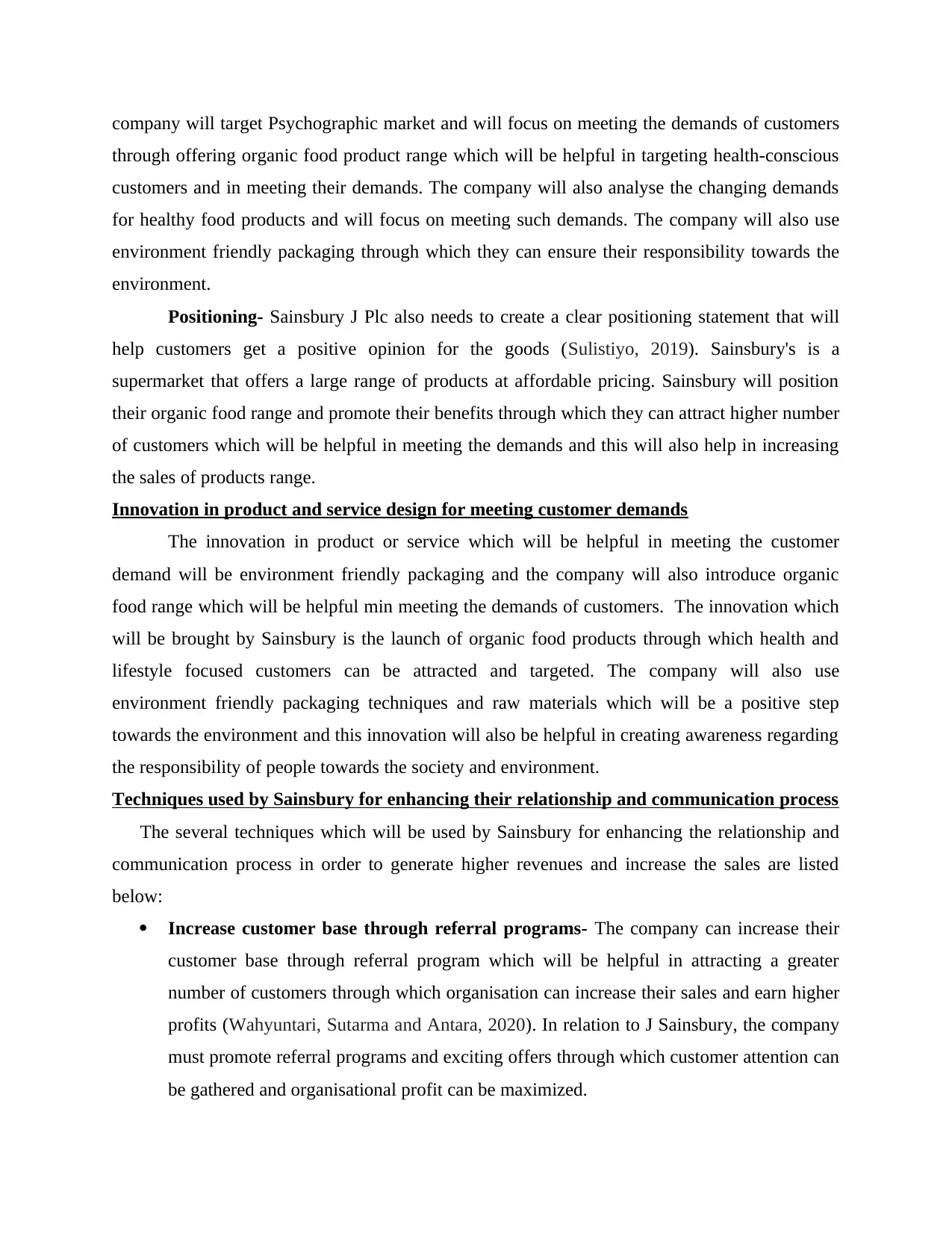
company will target Psychographic market and will focus on meeting the demands of customers
through offering organic food product range which will be helpful in targeting health-conscious
customers and in meeting their demands. The company will also analyse the changing demands
for healthy food products and will focus on meeting such demands. The company will also use
environment friendly packaging through which they can ensure their responsibility towards the
environment.
Positioning- Sainsbury J Plc also needs to create a clear positioning statement that will
help customers get a positive opinion for the goods (Sulistiyo, 2019). Sainsbury's is a
supermarket that offers a large range of products at affordable pricing. Sainsbury will position
their organic food range and promote their benefits through which they can attract higher number
of customers which will be helpful in meeting the demands and this will also help in increasing
the sales of products range.
Innovation in product and service design for meeting customer demands
The innovation in product or service which will be helpful in meeting the customer
demand will be environment friendly packaging and the company will also introduce organic
food range which will be helpful min meeting the demands of customers. The innovation which
will be brought by Sainsbury is the launch of organic food products through which health and
lifestyle focused customers can be attracted and targeted. The company will also use
environment friendly packaging techniques and raw materials which will be a positive step
towards the environment and this innovation will also be helpful in creating awareness regarding
the responsibility of people towards the society and environment.
Techniques used by Sainsbury for enhancing their relationship and communication process
The several techniques which will be used by Sainsbury for enhancing the relationship and
communication process in order to generate higher revenues and increase the sales are listed
below:
Increase customer base through referral programs- The company can increase their
customer base through referral program which will be helpful in attracting a greater
number of customers through which organisation can increase their sales and earn higher
profits (Wahyuntari, Sutarma and Antara, 2020). In relation to J Sainsbury, the company
must promote referral programs and exciting offers through which customer attention can
be gathered and organisational profit can be maximized.
through offering organic food product range which will be helpful in targeting health-conscious
customers and in meeting their demands. The company will also analyse the changing demands
for healthy food products and will focus on meeting such demands. The company will also use
environment friendly packaging through which they can ensure their responsibility towards the
environment.
Positioning- Sainsbury J Plc also needs to create a clear positioning statement that will
help customers get a positive opinion for the goods (Sulistiyo, 2019). Sainsbury's is a
supermarket that offers a large range of products at affordable pricing. Sainsbury will position
their organic food range and promote their benefits through which they can attract higher number
of customers which will be helpful in meeting the demands and this will also help in increasing
the sales of products range.
Innovation in product and service design for meeting customer demands
The innovation in product or service which will be helpful in meeting the customer
demand will be environment friendly packaging and the company will also introduce organic
food range which will be helpful min meeting the demands of customers. The innovation which
will be brought by Sainsbury is the launch of organic food products through which health and
lifestyle focused customers can be attracted and targeted. The company will also use
environment friendly packaging techniques and raw materials which will be a positive step
towards the environment and this innovation will also be helpful in creating awareness regarding
the responsibility of people towards the society and environment.
Techniques used by Sainsbury for enhancing their relationship and communication process
The several techniques which will be used by Sainsbury for enhancing the relationship and
communication process in order to generate higher revenues and increase the sales are listed
below:
Increase customer base through referral programs- The company can increase their
customer base through referral program which will be helpful in attracting a greater
number of customers through which organisation can increase their sales and earn higher
profits (Wahyuntari, Sutarma and Antara, 2020). In relation to J Sainsbury, the company
must promote referral programs and exciting offers through which customer attention can
be gathered and organisational profit can be maximized.
⊘ This is a preview!⊘
Do you want full access?
Subscribe today to unlock all pages.

Trusted by 1+ million students worldwide
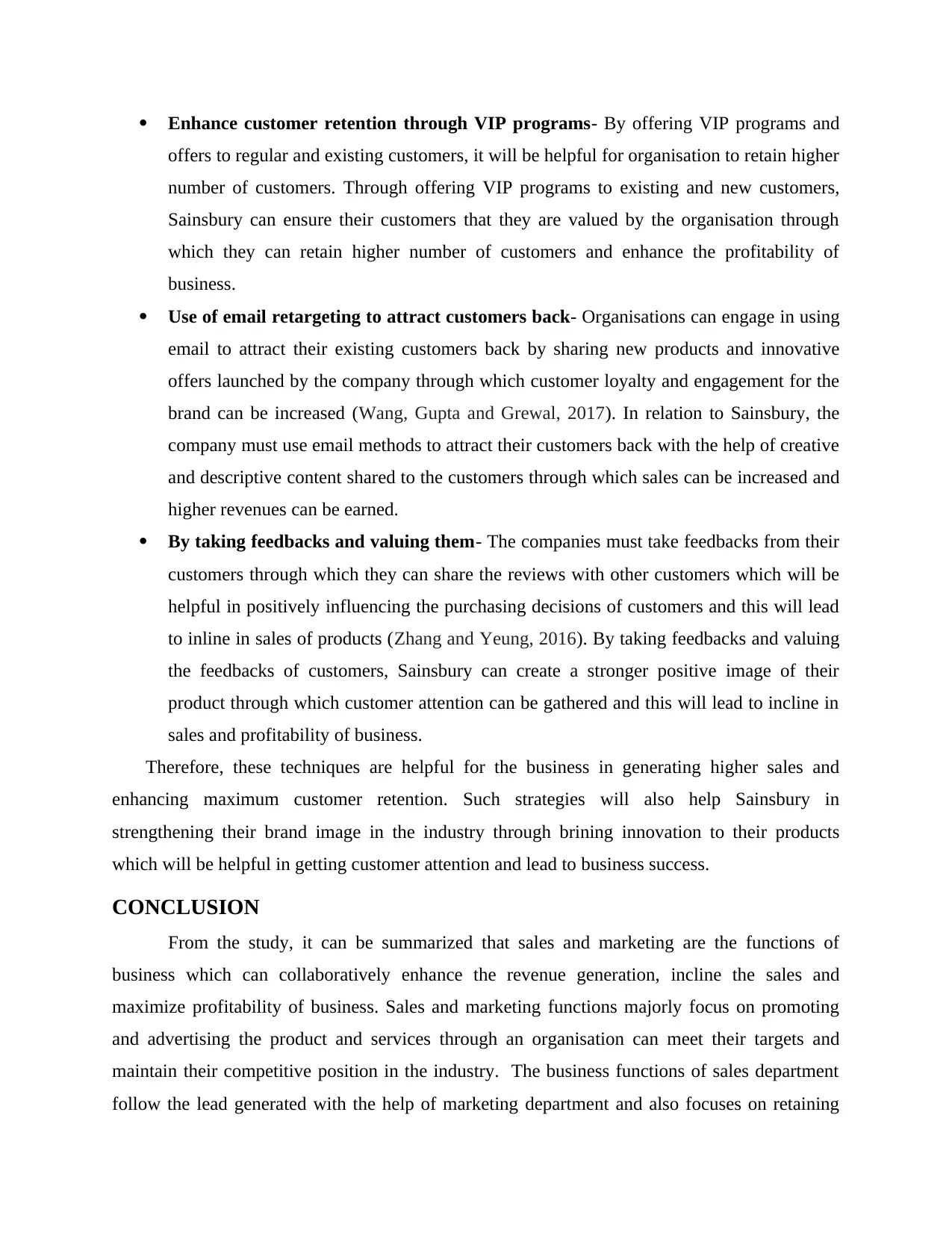
Enhance customer retention through VIP programs- By offering VIP programs and
offers to regular and existing customers, it will be helpful for organisation to retain higher
number of customers. Through offering VIP programs to existing and new customers,
Sainsbury can ensure their customers that they are valued by the organisation through
which they can retain higher number of customers and enhance the profitability of
business.
Use of email retargeting to attract customers back- Organisations can engage in using
email to attract their existing customers back by sharing new products and innovative
offers launched by the company through which customer loyalty and engagement for the
brand can be increased (Wang, Gupta and Grewal, 2017). In relation to Sainsbury, the
company must use email methods to attract their customers back with the help of creative
and descriptive content shared to the customers through which sales can be increased and
higher revenues can be earned.
By taking feedbacks and valuing them- The companies must take feedbacks from their
customers through which they can share the reviews with other customers which will be
helpful in positively influencing the purchasing decisions of customers and this will lead
to inline in sales of products (Zhang and Yeung, 2016). By taking feedbacks and valuing
the feedbacks of customers, Sainsbury can create a stronger positive image of their
product through which customer attention can be gathered and this will lead to incline in
sales and profitability of business.
Therefore, these techniques are helpful for the business in generating higher sales and
enhancing maximum customer retention. Such strategies will also help Sainsbury in
strengthening their brand image in the industry through brining innovation to their products
which will be helpful in getting customer attention and lead to business success.
CONCLUSION
From the study, it can be summarized that sales and marketing are the functions of
business which can collaboratively enhance the revenue generation, incline the sales and
maximize profitability of business. Sales and marketing functions majorly focus on promoting
and advertising the product and services through an organisation can meet their targets and
maintain their competitive position in the industry. The business functions of sales department
follow the lead generated with the help of marketing department and also focuses on retaining
offers to regular and existing customers, it will be helpful for organisation to retain higher
number of customers. Through offering VIP programs to existing and new customers,
Sainsbury can ensure their customers that they are valued by the organisation through
which they can retain higher number of customers and enhance the profitability of
business.
Use of email retargeting to attract customers back- Organisations can engage in using
email to attract their existing customers back by sharing new products and innovative
offers launched by the company through which customer loyalty and engagement for the
brand can be increased (Wang, Gupta and Grewal, 2017). In relation to Sainsbury, the
company must use email methods to attract their customers back with the help of creative
and descriptive content shared to the customers through which sales can be increased and
higher revenues can be earned.
By taking feedbacks and valuing them- The companies must take feedbacks from their
customers through which they can share the reviews with other customers which will be
helpful in positively influencing the purchasing decisions of customers and this will lead
to inline in sales of products (Zhang and Yeung, 2016). By taking feedbacks and valuing
the feedbacks of customers, Sainsbury can create a stronger positive image of their
product through which customer attention can be gathered and this will lead to incline in
sales and profitability of business.
Therefore, these techniques are helpful for the business in generating higher sales and
enhancing maximum customer retention. Such strategies will also help Sainsbury in
strengthening their brand image in the industry through brining innovation to their products
which will be helpful in getting customer attention and lead to business success.
CONCLUSION
From the study, it can be summarized that sales and marketing are the functions of
business which can collaboratively enhance the revenue generation, incline the sales and
maximize profitability of business. Sales and marketing functions majorly focus on promoting
and advertising the product and services through an organisation can meet their targets and
maintain their competitive position in the industry. The business functions of sales department
follow the lead generated with the help of marketing department and also focuses on retaining
Paraphrase This Document
Need a fresh take? Get an instant paraphrase of this document with our AI Paraphraser
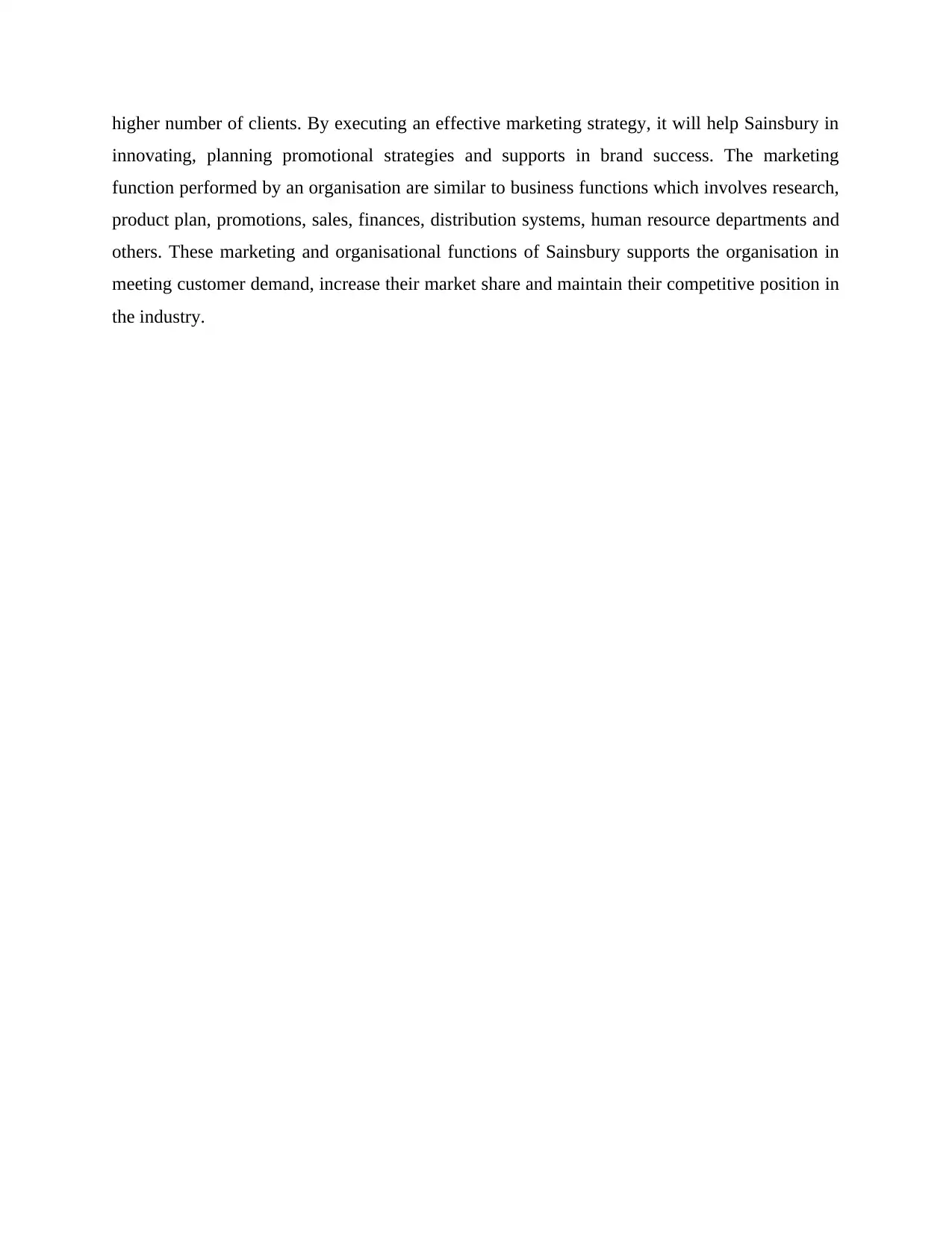
higher number of clients. By executing an effective marketing strategy, it will help Sainsbury in
innovating, planning promotional strategies and supports in brand success. The marketing
function performed by an organisation are similar to business functions which involves research,
product plan, promotions, sales, finances, distribution systems, human resource departments and
others. These marketing and organisational functions of Sainsbury supports the organisation in
meeting customer demand, increase their market share and maintain their competitive position in
the industry.
innovating, planning promotional strategies and supports in brand success. The marketing
function performed by an organisation are similar to business functions which involves research,
product plan, promotions, sales, finances, distribution systems, human resource departments and
others. These marketing and organisational functions of Sainsbury supports the organisation in
meeting customer demand, increase their market share and maintain their competitive position in
the industry.
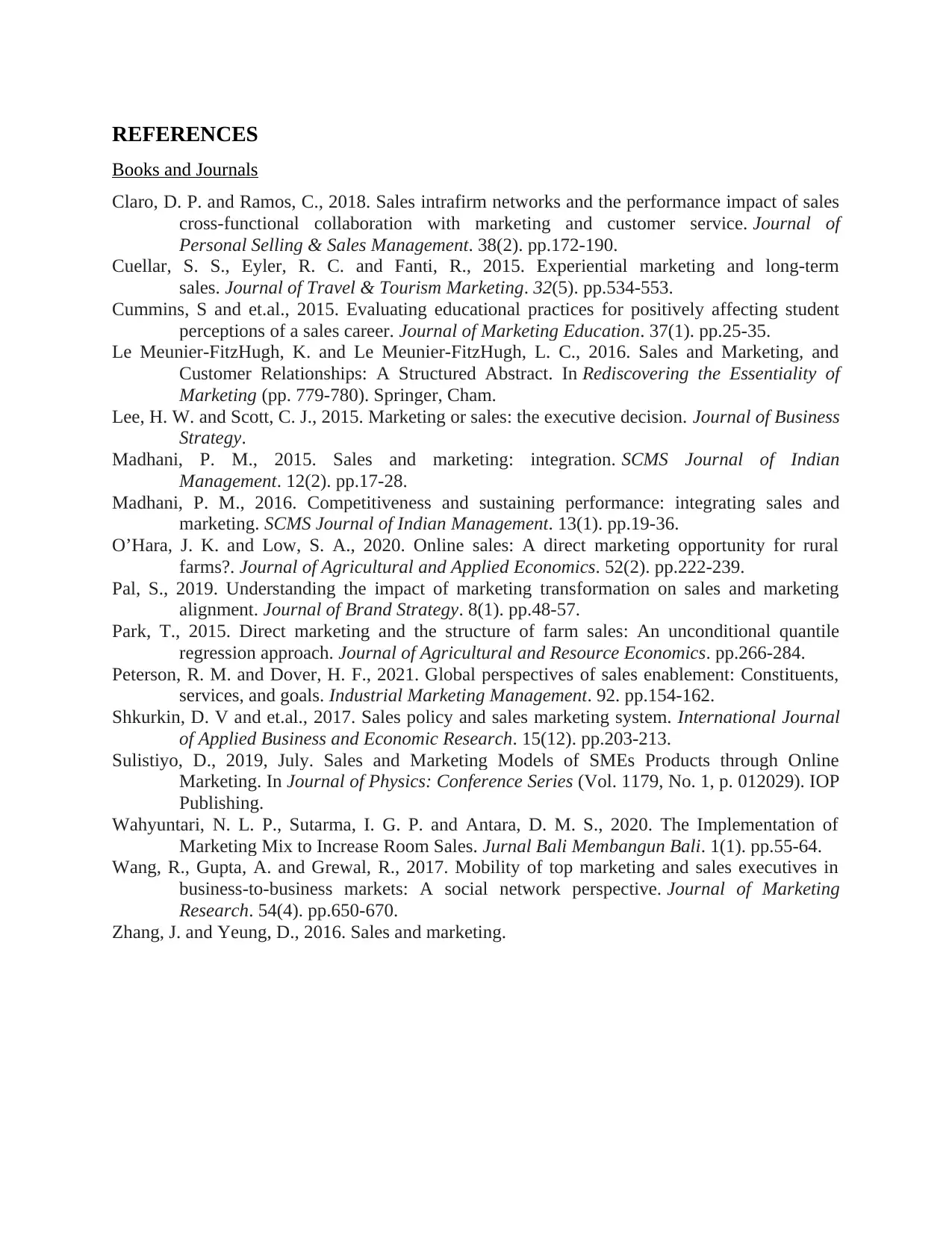
REFERENCES
Books and Journals
Claro, D. P. and Ramos, C., 2018. Sales intrafirm networks and the performance impact of sales
cross-functional collaboration with marketing and customer service. Journal of
Personal Selling & Sales Management. 38(2). pp.172-190.
Cuellar, S. S., Eyler, R. C. and Fanti, R., 2015. Experiential marketing and long-term
sales. Journal of Travel & Tourism Marketing. 32(5). pp.534-553.
Cummins, S and et.al., 2015. Evaluating educational practices for positively affecting student
perceptions of a sales career. Journal of Marketing Education. 37(1). pp.25-35.
Le Meunier-FitzHugh, K. and Le Meunier-FitzHugh, L. C., 2016. Sales and Marketing, and
Customer Relationships: A Structured Abstract. In Rediscovering the Essentiality of
Marketing (pp. 779-780). Springer, Cham.
Lee, H. W. and Scott, C. J., 2015. Marketing or sales: the executive decision. Journal of Business
Strategy.
Madhani, P. M., 2015. Sales and marketing: integration. SCMS Journal of Indian
Management. 12(2). pp.17-28.
Madhani, P. M., 2016. Competitiveness and sustaining performance: integrating sales and
marketing. SCMS Journal of Indian Management. 13(1). pp.19-36.
O’Hara, J. K. and Low, S. A., 2020. Online sales: A direct marketing opportunity for rural
farms?. Journal of Agricultural and Applied Economics. 52(2). pp.222-239.
Pal, S., 2019. Understanding the impact of marketing transformation on sales and marketing
alignment. Journal of Brand Strategy. 8(1). pp.48-57.
Park, T., 2015. Direct marketing and the structure of farm sales: An unconditional quantile
regression approach. Journal of Agricultural and Resource Economics. pp.266-284.
Peterson, R. M. and Dover, H. F., 2021. Global perspectives of sales enablement: Constituents,
services, and goals. Industrial Marketing Management. 92. pp.154-162.
Shkurkin, D. V and et.al., 2017. Sales policy and sales marketing system. International Journal
of Applied Business and Economic Research. 15(12). pp.203-213.
Sulistiyo, D., 2019, July. Sales and Marketing Models of SMEs Products through Online
Marketing. In Journal of Physics: Conference Series (Vol. 1179, No. 1, p. 012029). IOP
Publishing.
Wahyuntari, N. L. P., Sutarma, I. G. P. and Antara, D. M. S., 2020. The Implementation of
Marketing Mix to Increase Room Sales. Jurnal Bali Membangun Bali. 1(1). pp.55-64.
Wang, R., Gupta, A. and Grewal, R., 2017. Mobility of top marketing and sales executives in
business-to-business markets: A social network perspective. Journal of Marketing
Research. 54(4). pp.650-670.
Zhang, J. and Yeung, D., 2016. Sales and marketing.
Books and Journals
Claro, D. P. and Ramos, C., 2018. Sales intrafirm networks and the performance impact of sales
cross-functional collaboration with marketing and customer service. Journal of
Personal Selling & Sales Management. 38(2). pp.172-190.
Cuellar, S. S., Eyler, R. C. and Fanti, R., 2015. Experiential marketing and long-term
sales. Journal of Travel & Tourism Marketing. 32(5). pp.534-553.
Cummins, S and et.al., 2015. Evaluating educational practices for positively affecting student
perceptions of a sales career. Journal of Marketing Education. 37(1). pp.25-35.
Le Meunier-FitzHugh, K. and Le Meunier-FitzHugh, L. C., 2016. Sales and Marketing, and
Customer Relationships: A Structured Abstract. In Rediscovering the Essentiality of
Marketing (pp. 779-780). Springer, Cham.
Lee, H. W. and Scott, C. J., 2015. Marketing or sales: the executive decision. Journal of Business
Strategy.
Madhani, P. M., 2015. Sales and marketing: integration. SCMS Journal of Indian
Management. 12(2). pp.17-28.
Madhani, P. M., 2016. Competitiveness and sustaining performance: integrating sales and
marketing. SCMS Journal of Indian Management. 13(1). pp.19-36.
O’Hara, J. K. and Low, S. A., 2020. Online sales: A direct marketing opportunity for rural
farms?. Journal of Agricultural and Applied Economics. 52(2). pp.222-239.
Pal, S., 2019. Understanding the impact of marketing transformation on sales and marketing
alignment. Journal of Brand Strategy. 8(1). pp.48-57.
Park, T., 2015. Direct marketing and the structure of farm sales: An unconditional quantile
regression approach. Journal of Agricultural and Resource Economics. pp.266-284.
Peterson, R. M. and Dover, H. F., 2021. Global perspectives of sales enablement: Constituents,
services, and goals. Industrial Marketing Management. 92. pp.154-162.
Shkurkin, D. V and et.al., 2017. Sales policy and sales marketing system. International Journal
of Applied Business and Economic Research. 15(12). pp.203-213.
Sulistiyo, D., 2019, July. Sales and Marketing Models of SMEs Products through Online
Marketing. In Journal of Physics: Conference Series (Vol. 1179, No. 1, p. 012029). IOP
Publishing.
Wahyuntari, N. L. P., Sutarma, I. G. P. and Antara, D. M. S., 2020. The Implementation of
Marketing Mix to Increase Room Sales. Jurnal Bali Membangun Bali. 1(1). pp.55-64.
Wang, R., Gupta, A. and Grewal, R., 2017. Mobility of top marketing and sales executives in
business-to-business markets: A social network perspective. Journal of Marketing
Research. 54(4). pp.650-670.
Zhang, J. and Yeung, D., 2016. Sales and marketing.
⊘ This is a preview!⊘
Do you want full access?
Subscribe today to unlock all pages.

Trusted by 1+ million students worldwide
1 out of 12
Related Documents
Your All-in-One AI-Powered Toolkit for Academic Success.
+13062052269
info@desklib.com
Available 24*7 on WhatsApp / Email
![[object Object]](/_next/static/media/star-bottom.7253800d.svg)
Unlock your academic potential
Copyright © 2020–2025 A2Z Services. All Rights Reserved. Developed and managed by ZUCOL.





